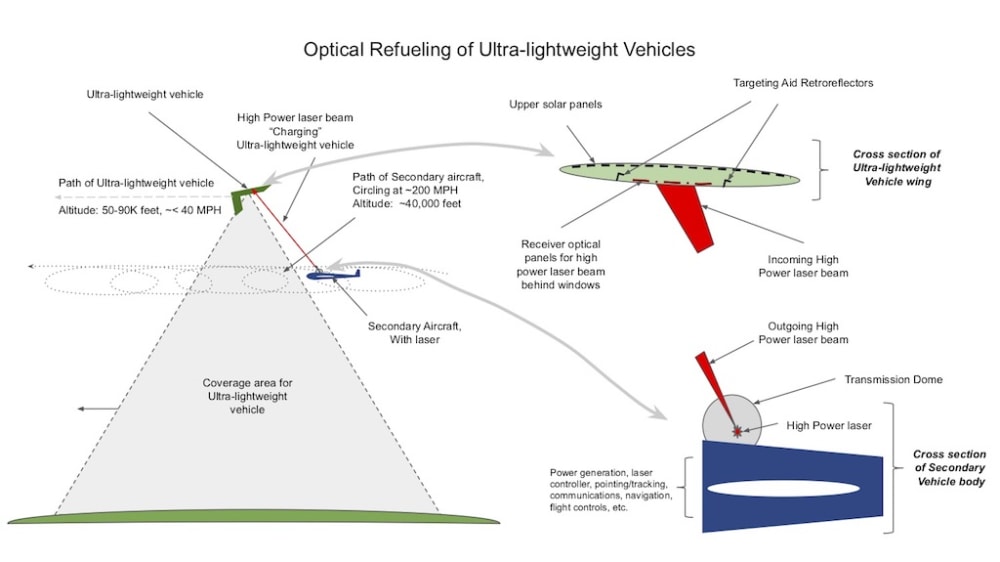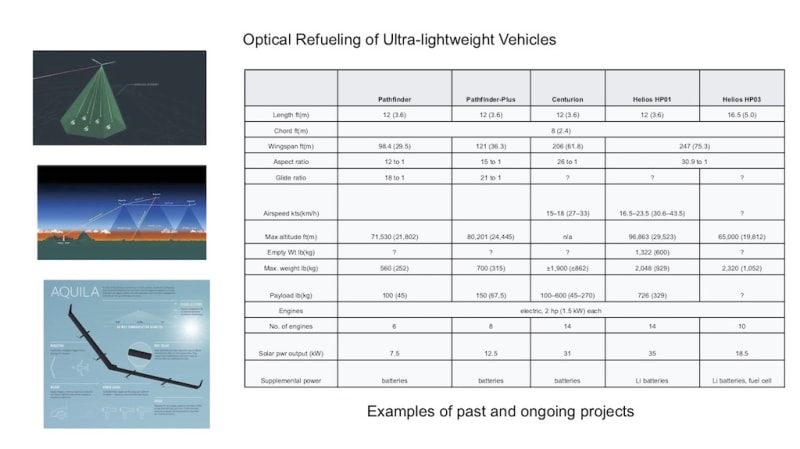Ultra-lightweight vehicles are being developed to provide a number of high tech, long duration functions during flight. Applications including: military, weather, shipping, safety, commercial, border control, etc. applications. These vehicles typically are large, fragile, solar powered aircraft operating at between 50,000 and 90,000 feet for days to months timeframes.They typically have solar panels on the top of the wings and banks of batteries to store energy for night time operation. Usually > 50% of the vehicle weight is for batteries alone.
This approach provides a way to secondarily charge the batteries, along with significantly (40 to 60%) reducing the weight of storage batteries required for operation. Additional optical panels, designed for specific wavelengths (with up to >80% conversion efficiencies) would be mounted to the bottom surfaces of the wings, along with targeting aids for tracking purposes. A secondary aircraft, flying at lower altitudes, and higher speeds will project a focused, high power laser beam, matched to the specific design wavelength of the receiver panels, converting that laser power to electrical energy for the batteries. Since this ‘target’ vehicle is slow moving, a cooperative target and of a known flight path, the aiming/targeting task can be done easily. Night time charging would actually be easier (signal to noise background) than day time charging. The technology to put focused, high power (multi kilowatt) ‘killer’ beams on incoming missiles has already been fielded and is commercially available.
This approach will increase the power available for the ‘operation’ of the vehicle while reducing the overall vehicle weight (mostly batteries). This will increase the overall reliability of the vehicle (battery or cell failures) and allow for longer flight ranges from ground support stations, and reduce the number of times the vehicle needs to be landed and serviced.
The ‘secondary’ flight charging vehicle can be a gas powered (remotely controlled) vehicle with tracking, laser and navigation equipment on board to track many receiver vehicles. It can re-charge many individual vehicles on a single flight path. Or, several ‘secondary’ vehicles can charge a single receiver vehicle simultaneously. With this approach, this primary vehicle can be put “on station’” and left indefinitely, being able to be re-charges as needed.
This approach also allows for the primary vehicle to be launched/landed at a more remote site, bypassing local weather, commercial flight restrictions and foreign border/overflight restrictions.
The ultra-lightweight vehicle typically flies at 50,000 to 90,000 ft, with a speed of about 40 mph and the secondary ‘recharge’ aircraft would fly at ~40,000 feet and at ~200 mph. The secondary vehicle can circle below the higher vehicle and ‘track’ it as the higher vehicle goes along it’s required path. The higher vehicle can have targeting retro-reflectors, around the optical receiver panels on the bottom of the wings, to aid in the targeting, acquisition and aiming of the high power ‘recharging’ beam. This provides a clear, stable ‘target’ return for the charging laser light.
Like this entry?
-
About the Entrant
- Name:Douglas Jungwirth
- Type of entry:individual
- Patent status:none





